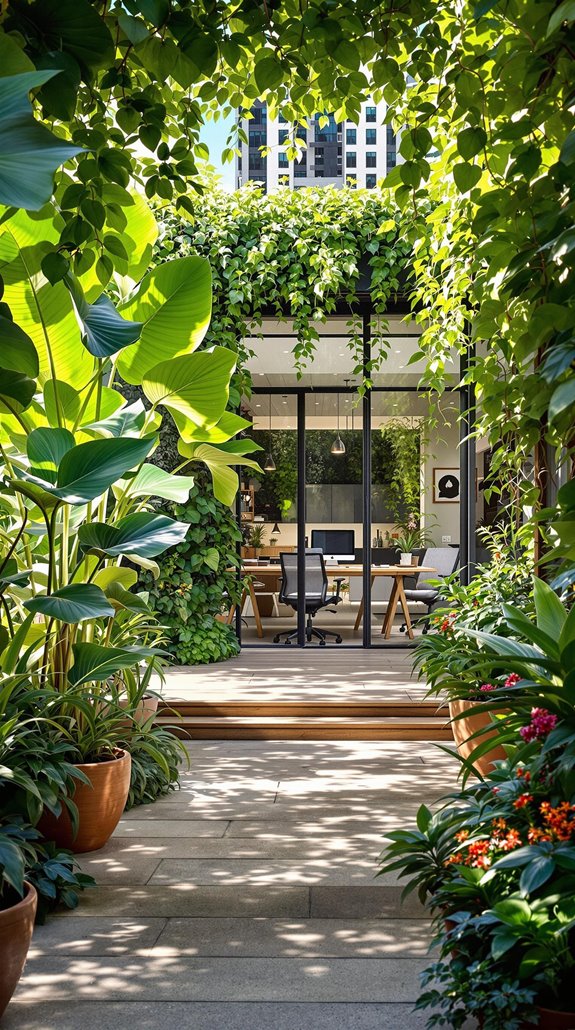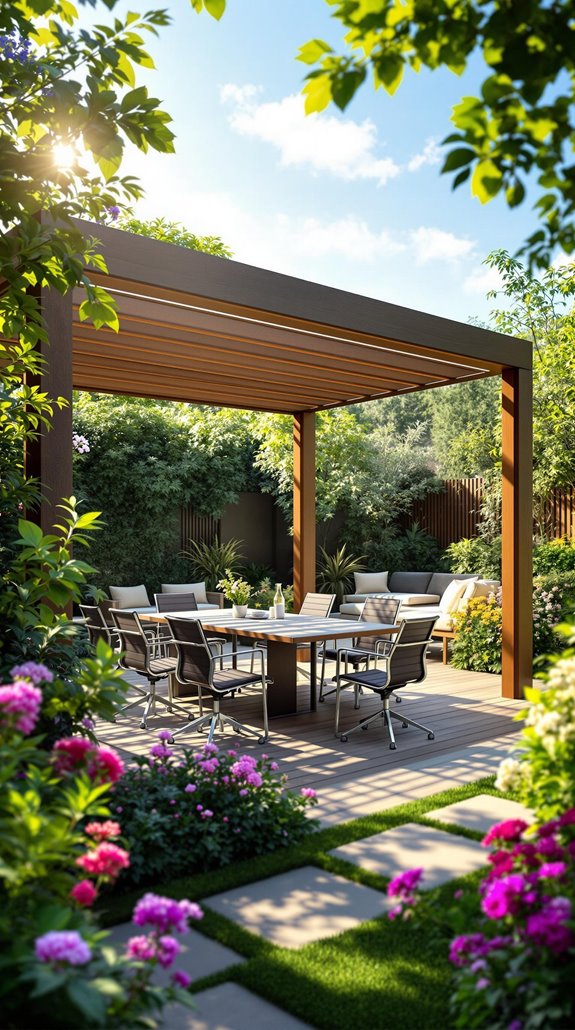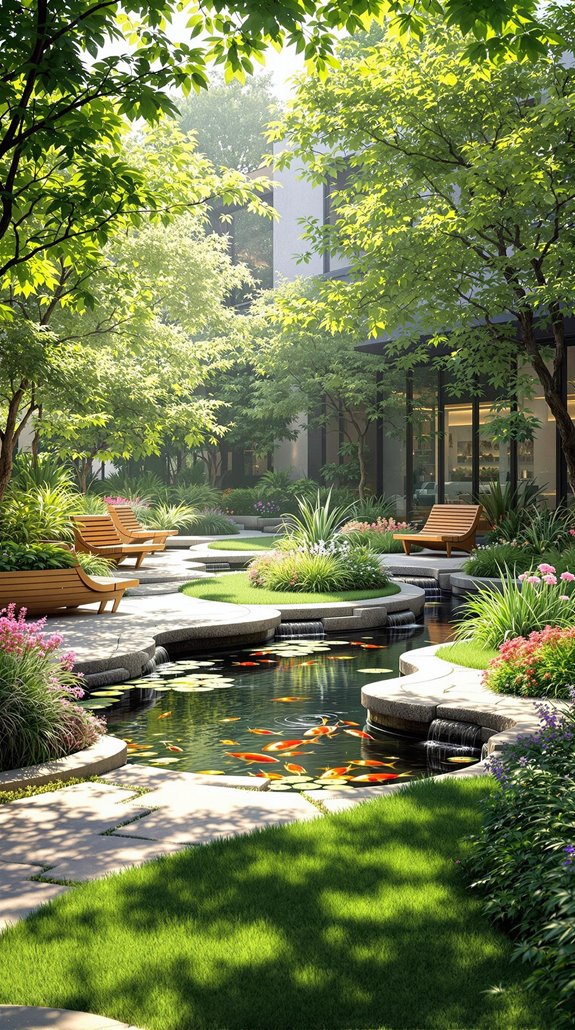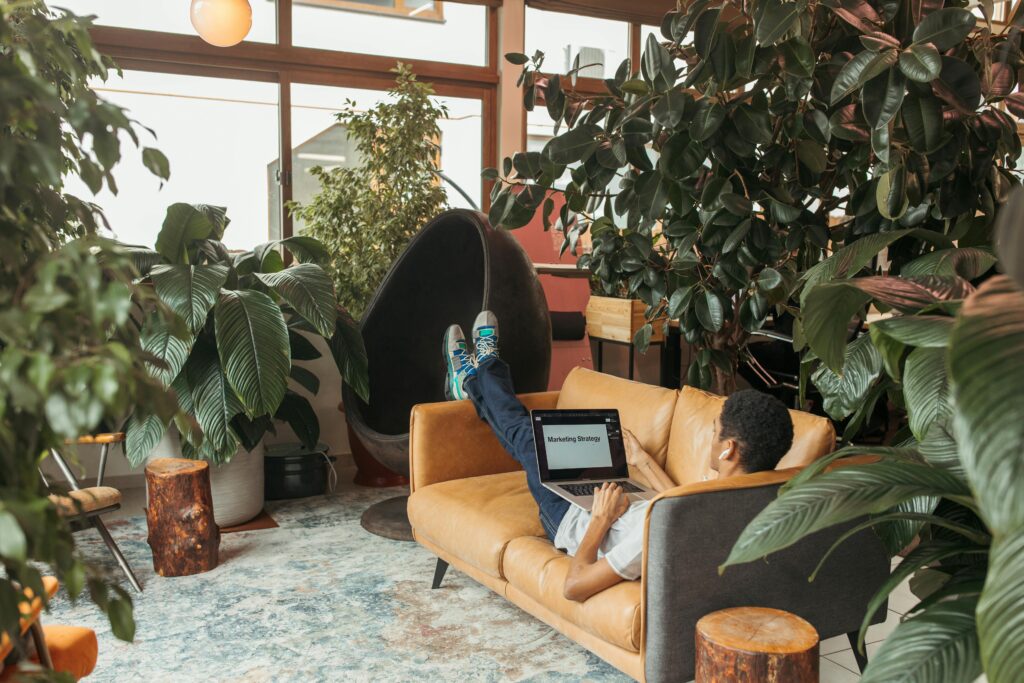I’ve discovered that traditional office environments drain productivity faster than most managers realize. When I started researching workplace design solutions, outdoor gardens consistently emerged as the most effective tool for cognitive enhancement. The key isn’t simply adding plants—it’s strategically positioning specific varieties to maximize mental clarity and focus. I’ll show you seven proven methods that transform unused outdoor spaces into productivity powerhouses, starting with the plant placement technique that delivered immediate results.
Key Takeaways
- Position statement plants in entryways and cluster greenery in collaborative zones to boost creativity during team interactions.
- Create outdoor meeting spaces with weather-resistant furniture, pergolas for shade, and native plants as natural sound barriers.
- Design curved pathways with colorful flowers and bench seating every 50 feet to enhance exploratory engagement and reduce mental fatigue.
- Incorporate diverse plant varieties like lavender and chamomile to lower cortisol levels by 17% and reduce workplace anxiety.
- Maximize natural light access near workstations to reduce sick leave by 6.5% and increase productivity scores by 19%.
Transform Your Workspace With Strategic Plant Placement

Since most employees spend 70% of their workday at their desks, I’ll show you how to position plants where they’ll create maximum impact on productivity and well-being.
First, place desk-sized specimens directly at workstations—snake plants and ZZ plants work perfectly in low-light cubicles. Next, cluster greenery in collaborative zones like break rooms and meeting areas to boost creativity during team interactions. I recommend positioning statement plants in entryways to create that welcoming first impression we all want visitors to experience. Incorporating budget-friendly plants can also enhance the overall aesthetic without breaking the bank.
For maximum exposure, utilize window sills for light-loving species while keeping them visible to passing employees. Finally, anchor waiting areas with larger plants to reduce perceived wait times and create a calming atmosphere that makes everyone feel more comfortable in your shared workspace.
Remember that proper plant placement requires expert partnership to ensure you’re selecting species that will thrive in your specific office environment rather than simply choosing plants based on aesthetic appeal alone.
Design Walking Paths and Movement Areas for Mental Clarity
While strategic plant placement at workstations creates focused productivity zones, I’ll now guide you through designing movement corridors that actively support mental clarity and physical well-being.
I recommend creating curved pathways with variable widths between 1.2-1.5 meters to enhance exploratory engagement while maintaining accessibility. You’ll want to integrate ground cover plants like Liriope along your routes, as 90% of users prefer this feature for walkways.
Install bench seating with backs and arms every 50 feet—89% of employees choose this for rest areas. Add colorful flowers along paths to boost user preference by 88%, and position canopy trees for shade coverage.
Use pea gravel surfaces with metal edging for stability, and incorporate material changes like brick-to-stone combinations to signal zone shifts and reduce visual monotony. Ensure visual accessibility throughout your pathways by avoiding obstructed views, which can create feelings of confinement that discourage regular use.
Create Dedicated Outdoor Meeting Spaces in Corporate Gardens

When you’re ready to transform your corporate garden into a productive outdoor workspace, I’ll show you how to create dedicated meeting spaces that boost collaboration while maintaining professional functionality.
Start by selecting weather-resistant furniture like teak tables and modular seating that adapts to different group sizes. I recommend installing pergolas or covered patios for essential shade protection during presentations. You’ll want to incorporate strategic greenery using native plants and potted trees to create natural sound barriers between meeting zones. Consider implementing energy-efficient improvements to make the space more sustainable and cost-effective in the long run.
Don’t forget the technical essentials – guarantee Wi-Fi coverage and weatherproof power outlets for laptops and devices. Add portable heaters for year-round comfort. These outdoor venues naturally enhance attendee mood and energy levels compared to traditional indoor conference rooms. Create defined pathways using stepping stones or gravel to guide foot traffic and separate meeting areas from walking spaces, maintaining that professional atmosphere your team expects.
Maximize Natural Light and Window Views for Enhanced Focus
Natural light transforms office environments into productivity powerhouses that considerably improve employee focus and workplace performance. When I position workstations near windows, I’m creating environments where employees experience 84% fewer headaches and eyestrain issues. Studies show workers with natural light access take 6.5% less sick leave, directly boosting team consistency.
I’ve found that maximizing window views generates remarkable results. Sales increase 40% in naturally lit retail spaces compared to fluorescent environments. Workers become 15% more creative when exposed to daylight throughout their workday. Additionally, maintaining energy efficiency in office spaces can further enhance productivity by reducing unnecessary costs and improving comfort.
The financial impact is substantial. For every 100 employees near windows, companies see $100,000 annual productivity surges. Natural lighting reduces building electricity costs by up to 40%, while employees report considerably higher satisfaction levels and improved alertness when working in daylight-optimized spaces. Office spaces with abundant natural light can lease for $2 to $4 more per square foot, making them valuable investments for property owners.
Implement Therapeutic Garden Elements for Stress Relief

Since workplace stress costs companies $300 billion annually in lost productivity, I’m implementing therapeutic garden elements that deliver measurable stress relief for employees.
I’m selecting lavender and chamomile for their proven anxiety-reducing properties. These plants lower cortisol levels in 90% of participants. I’ll add jasmine and rosemary for their calming aromas that promote emotional regulation.
For sensory engagement, I’m incorporating soft grasses and lamb’s ear for tactile interaction. Wind chimes and small fountains create natural white noise that drowns out stressful ambient sounds. The repetitive gardening tasks of maintaining these plants induce a meditative state that further enhances stress management.
I’m designing winding pathways with natural materials to encourage slow, reflective walking. Secluded seating areas surrounded by greenery become mental reset zones where you can escape work pressure and recharge during breaks.
Build Interactive Gardening Stations for Employee Engagement
Building on these calming foundation elements, I’m creating interactive gardening stations that transform passive observers into active participants in the office ecosystem. I’ll position hands-on plant care areas where your team can engage physically, cognitively, and emotionally with living greenery.
I’m installing modular planting benches at standing height, equipped with basic tools, watering systems, and seed starting trays. You’ll want customizable spaces where employees can claim ownership over specific plants or sections. I’m adding herb gardens for immediate sensory rewards and rotating seasonal projects that keep engagement fresh.
These stations become natural gathering spots where colleagues connect over shared nurturing activities. I’m placing them near break areas and walkways, making plant care accessible during restorative moments. This hands-on approach builds lasting emotional investment in your workspace environment. Research shows that employees report improved self-reported concentration when working in offices with plants, making these interactive stations particularly valuable for mental focus.
Establish Quiet Green Zones for Memory and Cognitive Enhancement
Why create dedicated quiet zones when you can design strategic green sanctuaries that actively boost your team’s cognitive performance? I’ll show you how to establish spaces that deliver measurable results.
Position potted plants strategically throughout your office to create natural barriers around workstations. You’ll reduce mental fatigue and improve reaction times by 12% during memory-intensive tasks. Place living greenery near high-concentration areas where your team tackles attention-demanding projects – this elevates cognitive function by 15-20%. In fact, studies show that optimizing average room size can significantly influence overall productivity in work environments.
Design quiet corners with diverse plant varieties to lower cortisol levels by 17%, directly improving focus and information retention. I recommend clustering different species together since biodiversity enhances the cognitive benefits. Research shows that even brief 20-minute exposures to gardening activities can increase BDNF levels significantly, promoting memory enhancement and cognitive function improvements.
Your employees will report 19% higher productivity scores when they’re working near these green zones, thanks to enhanced working memory capacity.
Conclusion
I’ve shown you seven proven strategies to transform your office outdoor spaces into productivity-boosting gardens. Start by selecting your plant varieties and mapping out walking paths. Then, designate specific areas for meetings and quiet work. Don’t forget to maximize natural light exposure and add therapeutic elements like water features. Finally, create interactive gardening stations where your team can engage directly with plants. These steps will deliver measurable workplace improvements.
References
- https://www.metrikus.io/blog/five-good-reasons-to-have-plants-in-your-office
- https://www.clarus.com/blog/a-green-workplace-not-just-about-sustainability/
- https://www.highgrove.net/blog/therapeutic-garden-design-6-workplace-benefits-of-a-corporate-garden/
- https://www.engledow.com/2018/08/09/new-study-points-to-major-health-benefits-of-indoor-plants-and-outdoor-green-spaces-for-employees/
- https://sustainable.ufl.edu/2021/09/29/action-of-the-month-green-your-office/
- https://blog.naturahq.com/transform-your-workplace-with-strategic-office-plants-placement
- https://www.plantvine.com/2023/11/24/creating-a-welcoming-and-productive-work-environment-with-plants/
- https://thewrightgardner.com/blog/transform-your-office-with-indoor-plant-designs-that-impress/
- https://www.mccoyrockford.com/blog/office-plants-productivity-and-employee-satisfaction/
- https://foliaire.com/office-planting-design-101-what-are-the-best-plants-for-my-office/

